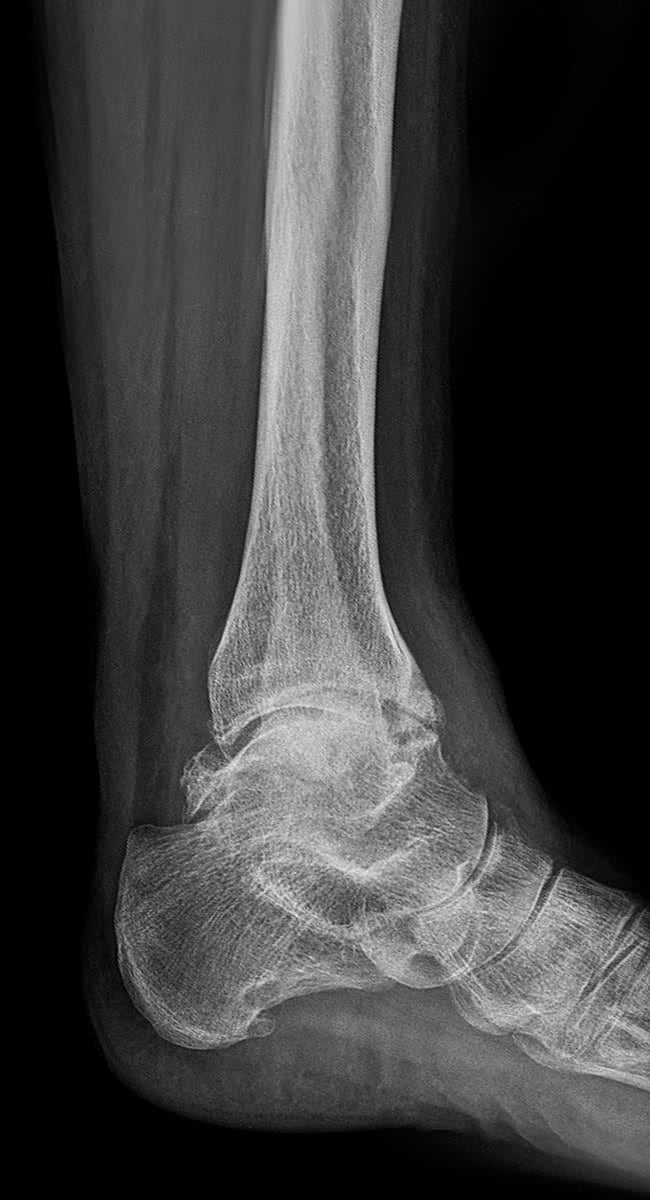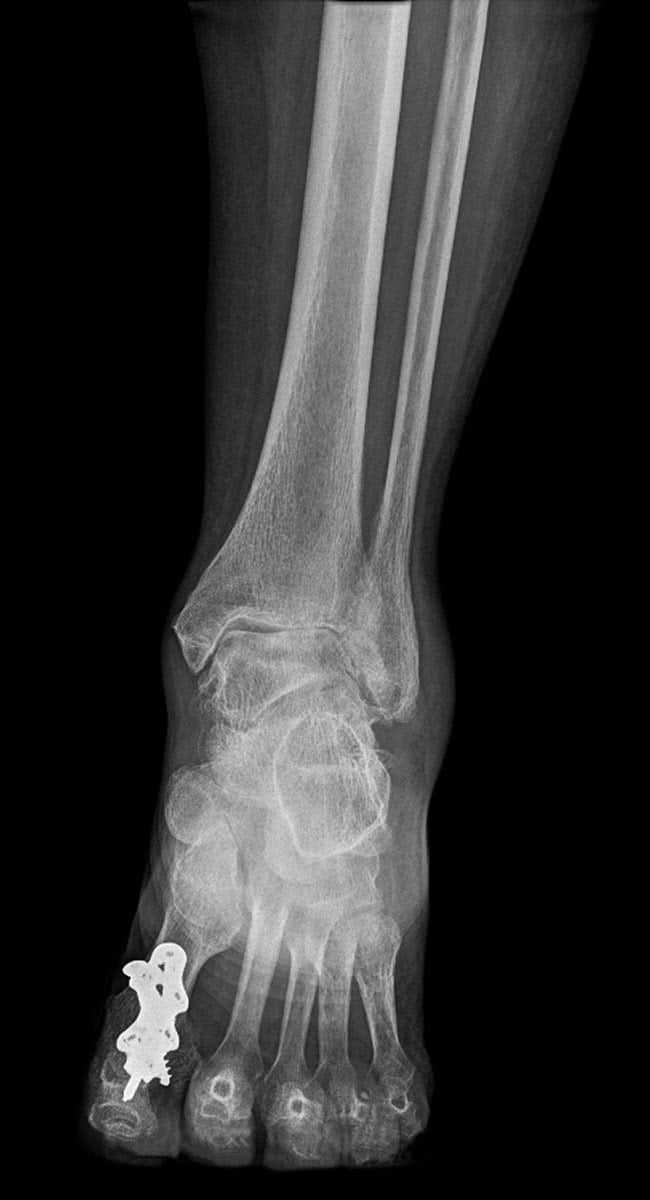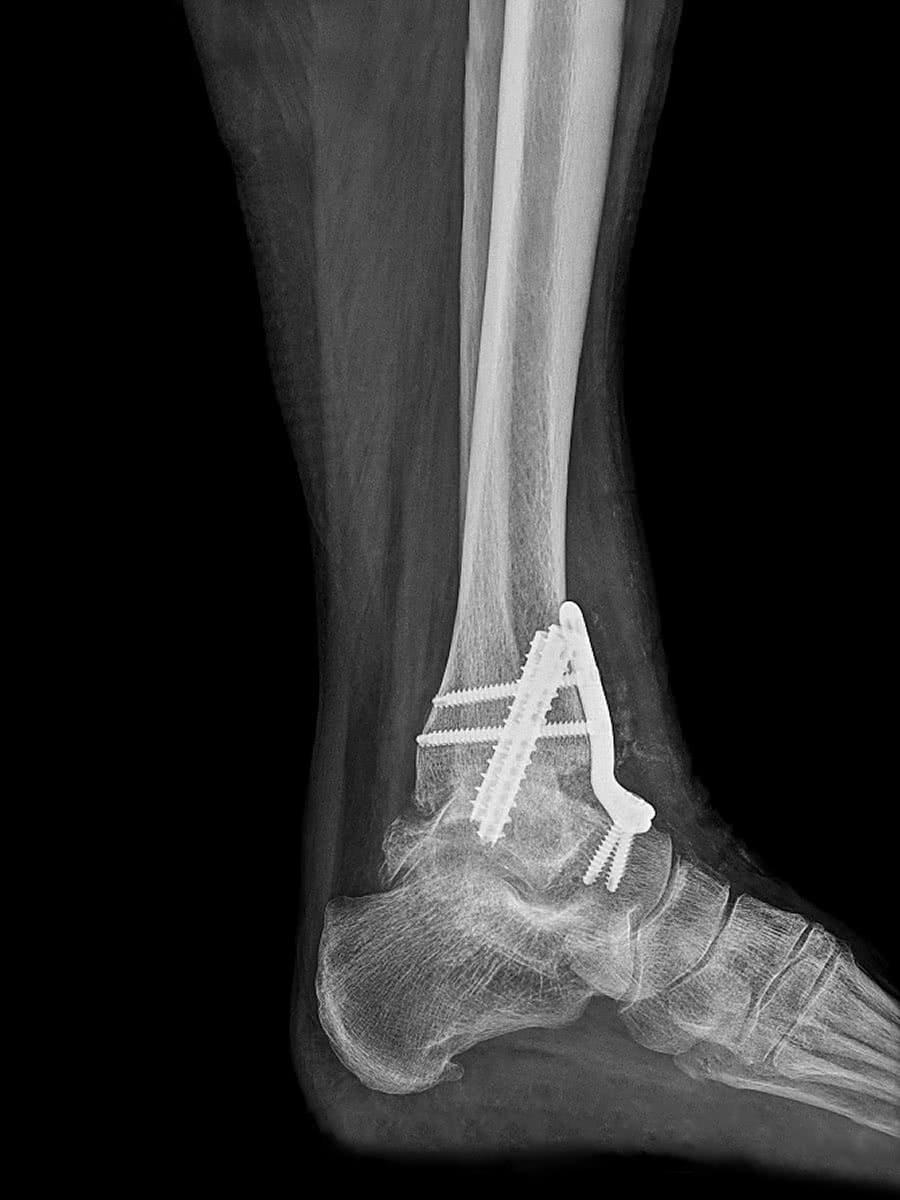Introduction
Ankle fusion, also referred to as ‘ankle arthrodesis’ is a procedure where the bones of the ankle joint are fused together so they form one section. See also the section on Anatomy of the foot and ankle.
Indications
The primary reason for undergoing an ankle fusion procedure is to relieve the symptoms of severe ankle arthritis. This may be due to degenerative osteoarthritis, rheumatoid, gout or other causes. The time to consider undergoing surgery is when the pain in your joint(s) is so severe that it is having a significant impact on your day to day activities. It is important that you have tried all reasonable non-surgical treatments, as some patients with severe arthritis on their x-rays can still cope quite well without surgery. It is not until your pain is fairly constant and severe that the potential benefits of surgery outweigh the risks and make it worthwhile going through the recovery period.
Patients with diabetes, rheumatoid arthritis, or who smoke, are at a much higher risk of complications from surgery and may choose to avoid an operation at all
Preoperative Instructions
You will be given a full briefing of how to prepare for your ankle fusion procedure well in advance of the day of surgery. In very general terms you will need to...
- Let our team know what other medication you are taking and follow our guidelines on taking these medications in the days/weeks before surgery.
- This is particularly pertinent to blood thinning medications such as aspirin, warfarin, clopidogrel and Xarelto.
- Let our team know if you develop symptoms of any illness (including a cold or fever) or if you believe you may be pregnant.
- If you smoke, stop smoking ideally several days or weeks ahead of the procedure, but at the very least not smoke after midnight the night before surgery.
- Maintain your strength and mobility as best as possible, some patients attend physiotherapy prior to the surgery in preparation.
- Not eat or drink anything for a minimum of 8 hours prior to admission.
- Bring all available and relevant imaging with you to hospital.
Procedure




In most cases the procedure is carried out using conventional (open) surgery techniques, for some patients it is carried out using minimally invasive (also known as ‘keyhole’ or ‘arthroscopic’) techniques using smaller incisions and the aid of a video camera and specialized small instruments. The recovery time for each is the same though.
Ankle arthrodesis is normally carried out under a general anaesthetic. One or more incisions are made in the skin around the ankle to allow access to the joint.
If there is still any cartilage tissue in the joints being fused, this is removed, and the bones prepared by roughening the surfaces. At this point the bones are attached to each other using special medical grade plates, nails and screws. In some cases, a bone graft is used to assist in the fusion process. This graft may be taken from the knee or pelvis, but more commonly, bone growth factors manufactured in a laboratory, are used to help stimulate and accelerate bone healing. The principle is that this process is trying to mimic a fractured bone, such that the two bones will knit together into one solid mass.
Where the subtalar joint is involved, a rod or nail may need to be inserted into the centre of the bone to keep the joints in place. Very occasionally the ankle needs to be kept in position using external pins and bars.
During surgery x-rays allow the surgical team to review the placing of attachments and alignment of the joint.
Once the procedure is complete and positioning has been checked, incisions are closed and a cast or cam boot splint is applied to keep the ankle in place while the fusion heals.
Postoperative Instructions
Immediately after surgery, the foot must be kept elevated (above the level of the heart) to reduce swelling. This is especially important over the first 2 weeks. Patients also receive pain medication at this time.
The fusion process normally takes 6-8 weeks to fuse sufficiently for you to be able to put weight on the foot (although in some cases it can take up to 12 weeks). During this time, you will need to use various aids to get about, such as scooters, crutches and walkers, and other aids to continue daily life, such as railings and ramps. You will also probably need some assistance with day-to-day activities and it may be easier if your bedroom is upstairs, to transfer your bed to the ground floor.
You may not be allowed to drive during this period. If it is the left foot and you drive an automatic, this might be allowed earlier.
Around two weeks after surgery the wounds are checked, but it is very important not to put any weight on the foot for at least 6 weeks. After this period, x-rays will be checked, and if all is going well it will be possible to start putting weight on the foot in a cam walker boot. Usually by 10-12 weeks the bones are well healed together and you can start walking without the boot.
Once fully healed you should be able to resume most of your activities prior to surgery, such as walking longer distances, climbing stairs and ladders and reasonably heavy manual work. The only activity that patients are unlikely to be able to do again is run.
Risks
All surgery carries with it some form of risk. Common risks that apply to all surgery, including an ankle fusion procedure, are...
- Bleeding.
- Formation of a blood clot (“DVT” or deep vein thrombosis) Pieces of clot in the leg can break off and lodge in the lungs causing a pulmonary embolism. This can be very serious, and in rare cases even cause death.
- Infection.
- Nerve damage.
- Difficulty getting the wound(s) to heal.
- Abnormal pain reactions or nerve hypersensitisation known as complex regional pain syndrome (CRPS).
Risks specifically related to this procedure include...
- Malposition of the joint causing abnormal pressure or stress elsewhere in the foot. This could require a second operation to adjust.
- Failure of the bones in the ankle to fuse (’nonunion’) The risk of this is around 1 in 10 and if this occurs, a second procedure will be necessary using a bone graft.
- Increased risk of arthritis in other joints - this is due to greater loads being placed on these joints (this is a longer-term risk where symptoms, if they do appear, generally take many years to develop).
- Development of arthritis in the subtalar joint (below the fused joint) - this sometimes occurs 10-20 years after the original procedure.
Dr Callahan will be able to discuss all of the details relating to risks and benefits of the procedure at your initial meeting.
Related Information
Anatomy of the Foot and Ankle
Ankle Arthritis
MetaFix™ TTF Plate
Ankle Arthrodesis
